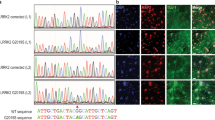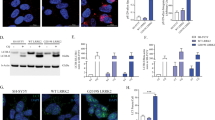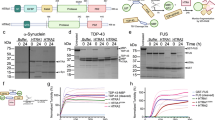Abstract
α-Synuclein is phosphorylated at serine 129 (Ser129) in intracellular protein aggregates called Lewy bodies. These inclusion bodies are the characteristic pathologic lesions of Parkinson disease. Here we define the role of phosphorylation of Ser129 in α-synuclein toxicity and inclusion formation using a Drosophila model of Parkinson disease. Mutation of Ser129 to alanine to prevent phosphorylation completely suppresses dopaminergic neuronal loss produced by expression of human α-synuclein. In contrast, altering Ser129 to the negatively charged residue aspartate, to mimic phosphorylation, significantly enhances α-synuclein toxicity. The G protein–coupled receptor kinase 2 (Gprk2) phosphorylates Ser129 in vivo and enhances α-synuclein toxicity. Blocking phosphorylation at Ser129 substantially increases aggregate formation. Thus Ser129 phosphorylation status is crucial in mediating α-synuclein neurotoxicity and inclusion formation. Because increased number of inclusion bodies correlates with reduced toxicity, inclusion bodies may protect neurons from α-synuclein toxicity.
This is a preview of subscription content, access via your institution
Access options
Subscribe to this journal
Receive 12 print issues and online access
$209.00 per year
only $17.42 per issue
Buy this article
- Purchase on Springer Link
- Instant access to full article PDF
Prices may be subject to local taxes which are calculated during checkout






Similar content being viewed by others
References
Iwai, A. et al. The precursor protein of non-Aβ component of Alzheimer's disease amyloid is a presynaptic protein of the central nervous system. Neuron 14, 467–475 (1995).
Chandra, S. et al. Double-knockout mice for α- and β-synucleins: effect on synaptic functions. Proc. Natl. Acad. Sci. USA 101, 14966–14971 (2004).
Polymeropoulos, M.H. et al. Mutation in the α-synuclein gene identified in families with Parkinson's disease. Science 276, 2045–2047 (1997).
Kruger, R. et al. Ala30Pro mutation in the gene encoding α-synuclein in Parkinson's disease. Nat. Genet. 18, 106–108 (1998).
Zarranz, J.J. et al. The new mutation, E46K, of α-synuclein causes Parkinson and Lewy body dementia. Ann. Neurol. 55, 164–173 (2004).
Singleton, A.B. et al. α-Synuclein locus triplication causes Parkinson's disease. Science 302, 841 (2003).
Spillantini, M.G. et al. α-Synuclein in Lewy bodies. Nature 388, 839–840 (1997).
Fujiwara, H. α-Synuclein is phosphorylated in synucleinopathy lesions. Nat. Cell Biol. 4, 160–164 (2002).
Giasson, B.I. et al. Oxidative damage linked to neurodegeneration by selective α-synuclein nitration in synucleinopathy lesions. Science 290, 985–989 (2000).
Shimura, H. et al. Ubiquitination of a new form of α-synuclein by parkin from human brain: implications for Parkinson's disease. Science 293, 263–269 (2001).
Okochi, M. et al. Constitutive phosphorylation of the Parkinson's disease associated α-synuclein. J. Biol. Chem. 275, 390–397 (2000).
Pronin, A.N., Morris, A.J., Surguchov, A. & Benovic, J.L. Synucleins are a novel class of substrates for G protein-coupled receptor kinases. J. Biol. Chem. 275, 26515–26522 (2000).
Ellis, C.E., Schwartzberg, P.L., Grider, T.L., Fink, D.W. & Nussbaum, R.L. α-Synuclein is phosphorylated by members of the Src family of protein-tyrosine kinases. J. Biol. Chem. 276, 3879–3884 (2001).
Saito, Y. et al. Accumulation of phosphorylated α-synuclein in aging human brain. J. Neuropathol. Exp. Neurol. 62, 644–654 (2003).
Ross, C.A. & Poirier, M.A. Protein aggregation and neurodegenerative disease. Nat. Med. 10 (Suppl.), S10–S17 (2004).
Feany, M.B. & Bender, W.W. A Drosophila model of Parkinson's disease. Nature 404, 394–398 (2000).
Takahashi, M. et al. Phosphorylation of α-synuclein characteristic of synucleinopathy lesions is recapitulated in α-synuclein transgenic Drosophila. Neurosci. Lett. 336, 155–158 (2003).
Leger, J., Kempf, M., Lee, G. & Brandt, R. Conversion of serine to aspartate imitates phosphorylation-induced changes in the structure and function of microtubule-associated protein tau. J. Biol. Chem. 272, 8441–8446 (1997).
Auluck, P.K., Meulener, M.C. & Bonini, N.M. Mechanisms of suppression of α-synuclein neurotoxicity by geldanamycin in Drosophila. J. Biol. Chem. 280, 2873–2878 (2005).
Auluck, P.K., Chan, H.Y., Trojanowski, J.Q., Lee, V.M. & Bonini, N.M. Chaperone suppression of α-synuclein toxicity in a Drosophila model for Parkinson's disease. Science 295, 865–868 (2002).
Yang, Y., Nishimura, I., Imai, Y., Takahashi, R. & Lu, B. Parkin suppresses dopaminergic neuron-selective neurotoxicity induced by Pael-R in Drosophila. Neuron 37, 911–924 (2003).
Cassill, J.A., Whitney, M., Joazeiro, C.A., Becker, A. & Zuker, C.S. Isolation of Drosophila genes encoding G protein-coupled receptor kinases. Proc. Natl. Acad. Sci. USA 88, 11067–11070 (1991).
Li, H., Chaney, S., Roberts, I.J., Forte, M. & Hirsh, J. Ectopic G-protein expression in dopamine and serotonin neurons blocks cocaine sensitization in Drosophila melanogaster. Curr. Biol. 10, 211–214 (2000).
Neumann, M. et al. Misfolded proteinase K-resistant hyperphosphorylated α-synuclein in aged transgenic mice with locomotor deterioration and in human α-synucleinopathies. J. Clin. Invest. 110, 1429–1439 (2002).
Conway, K.A. et al. Acceleration of oligomerization, not fibrillization, is a shared property of both α-synuclein mutations linked to early-onset Parkinson's disease: implications for pathogenesis and therapy. Proc. Natl. Acad. Sci. USA 97, 571–576 (2000).
Giasson, B.I., Uryu, K., Trojanowski, J.Q. & Lee, V.M. Mutant and wild type human α-synucleins assemble into elongated filaments with distinct morphologies in vitro. J. Biol. Chem. 274, 7619–7622 (1999).
Giasson, B.I., Murray, I.V., Trojanowski, J.Q. & Lee, V.M. A hydrophobic stretch of 12 amino acid residues in the middle of α-synuclein is essential for filament assembly. J. Biol. Chem. 276, 2380–2386 (2001).
Forloni, G. Neurotoxicity of β-amyloid and prion peptides. Curr. Opin. Neurol. 9, 492–500 (1996).
Pals, P. et al. α-Synuclein promoter confers susceptibility to Parkinson's disease. Ann. Neurol. 56, 591–595 (2004).
Valente, E.M. et al. Hereditary early-onset Parkinson's disease caused by mutations in PINK1. Science 304, 1158–1160 (2004).
Paisan-Ruiz, C. et al. Cloning of the gene containing mutations that cause PARK8-linked Parkinson's disease. Neuron 44, 595–600 (2004).
Zimprich, A. et al. Mutations in LRRK2 cause autosomal-dominant parkinsonism with pleomorphic pathology. Neuron 44, 601–607 (2004).
Goldberg, M.S. & Lansbury, P.T., Jr. Is there a cause-and-effect relationship between α-synuclein fibrillization and Parkinson's disease? Nat. Cell Biol. 2, E115–E119 (2000).
Collins, S.R., Douglass, A., Vale, R.D. & Weissman, J.S. Mechanism of prion propagation: amyloid growth occurs by monomer addition. PLoS Biol. 2, e321 (2004).
Saudou, F., Finkbeiner, S., Devys, D. & Greenberg, M.E. Huntingtin acts in the nucleus to induce apoptosis but death does not correlate with the formation of intranuclear inclusions. Cell 95, 55–66 (1998).
Arrasate, M., Mitra, S., Schweitzer, E.S., Segal, M.R. & Finkbeiner, S. Inclusion body formation reduces levels of mutant huntingtin and the risk of neuronal death. Nature 431, 805–810 (2004).
Matsuo, E.S. et al. Biopsy-derived adult human brain tau is phosphorylated at many of the same sites as Alzheimer's disease paired helical filament tau. Neuron 13, 989–1002 (1994).
Lee, M.K. et al. Human α-synuclein-harboring familial Parkinson's disease-linked Ala-53 → Thr mutation causes neurodegenerative disease with α-synuclein aggregation in transgenic mice. Proc. Natl. Acad. Sci. USA 99, 8968–8973 (2002).
Cruz, J.C., Tseng, H.C., Goldman, J.A., Shih, H. & Tsai, L.H. Aberrant Cdk5 activation by p25 triggers pathological events leading to neurodegeneration and neurofibrillary tangles. Neuron 40, 471–483 (2003).
Shulman, J.M. & Feany, M.B. Genetic modifiers of tauopathy in Drosophila. Genetics 165, 1233–1242 (2003).
Jackson, G.R. et al. Human wild-type tau interacts with wingless pathway components and produces neurofibrillary pathology in Drosophila. Neuron 34, 509–519 (2002).
Chen, H.K. et al. Interaction of Akt-phosphorylated ataxin-1 with 14–3-3 mediates neurodegeneration in spinocerebellar ataxia type 1. Cell 113, 457–468 (2003).
Choi, J.Y. et al. Rapid purification and analysis of α-synuclein proteins: C-terminal truncation promotes the conversion of α-synuclein into a protease-sensitive form in Escherichia coli. Biotechnol. Appl. Biochem. 36, 33–40 (2002).
Acknowledgements
We thank D. Teplow for advice on protein fibrillization experiments, T. Iwatsubo for providing psyn#64 antibody and C.S. Zuker for the Gprk2 antibody. This study was funded by grants from the US National Institutes of Health (AG88001, NS41536) to M.B.F.
Author information
Authors and Affiliations
Corresponding author
Ethics declarations
Competing interests
The authors declare no competing financial interests.
Supplementary information
Supplementary Fig. 1
Quantitative comparison of α-synuclein expression levels in transgenic flies. (a) Fly heads were homogenized and serial loadings (1, 1/2, 1/4 head equivalents from left to right for each genotype) were analysed with antibody against total α-synuclein. WT, gmr-GAL4; UAS-α-synuclein; S129A, gmr-GAL4; UAS-S129A; S129D, gmr-GAL4; UAS-S129D. (b) Intensities of the corresponding bands were quantitated by a densitometer using NIH ImageJ program. Readings from wild-type α-synuclein group were normalized to 1 and relative intensity ratios were calculated. Values represent mean ± SEM. Flies were 1 day old. (JPG 48 kb)
Supplementary Fig. 2
Inclusion formation and phospho-synuclein immunoreactivity in dopaminergic neurons. (a) psyn#64 detected phosphorylated α-synuclein deposition in thread and grain-like structures in the dorsomedial neuropil in flies expressing wild-type α-synuclein (elav-GAL4/+; UAS-α-synuclein/+). (b) Inclusion bodies (arrow heads) in a dorsomedial dopamine neuron in a transgenic fly expressing S129A α-synuclein (Ddc-GAL4/+; UAS-S129A/+). Flies were 20 days old. (JPG 25 kb)
Supplementary Fig. 3
Fibrillization of α-synuclein. (a) The turbidity due to protein aggregation of either wild-type or mutant α-synuclein was monitored by measuring absorbance at 405 nm. A53T aggregates most rapidly whereas differences in aggregation among wild-type, S129A, and S129D α-synuclein were not seen. Values represent mean α SEM of four independent experiments. (b-d) Negatively stained electron micrographs of filaments assembled in vitro from wild-type (b), S129A (c), or S129D α-synuclein (d). (e) Sarkosyl insoluble filaments extracted from fly brains expressing wild-type α-synuclein. The 10-nm gold particles attached to the secondary antibody appear as black dots. The scale bar equals 100 nm. (JPG 89 kb)
Supplementary Fig. 4
Western blot analysis of α-synuclein differentially extracted from fly heads expressing wild-type α-synuclein. The same membrane was sequentially labelled with the psyn#64 and clone 42. Flies were 30 days old. (JPG 29 kb)
Rights and permissions
About this article
Cite this article
Chen, L., Feany, M. α-Synuclein phosphorylation controls neurotoxicity and inclusion formation in a Drosophila model of Parkinson disease. Nat Neurosci 8, 657–663 (2005). https://doi.org/10.1038/nn1443
Received:
Accepted:
Published:
Issue Date:
DOI: https://doi.org/10.1038/nn1443
This article is cited by
-
Prosaposin maintains lipid homeostasis in dopamine neurons and counteracts experimental parkinsonism in rodents
Nature Communications (2023)
-
Altered neural cell junctions and ion-channels leading to disrupted neuron communication in Parkinson’s disease
npj Parkinson's Disease (2022)
-
An Update on the Critical Role of α-Synuclein in Parkinson’s Disease and Other Synucleinopathies: from Tissue to Cellular and Molecular Levels
Molecular Neurobiology (2022)
-
Cancerous Inhibitor of Protein Phosphatase 2A (CIP2A): Could It Be a Promising Biomarker and Therapeutic Target in Parkinson’s Disease?
Molecular Neurobiology (2022)
-
Initiation and progression of α-synuclein pathology in Parkinson’s disease
Cellular and Molecular Life Sciences (2022)



